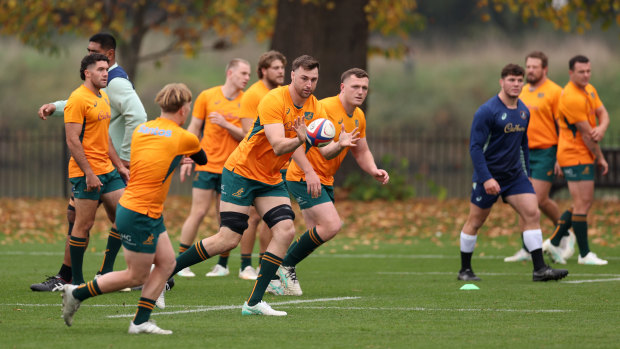This was published 6 months ago
Talk about a revolution? Wallabies weren’t even aware of LIV-style rugby breakaway league
By Iain Payten
Cardiff: Test lock Nick Frost said he hoped playing for the Wallabies would remain the pinnacle for young Australians as news of a proposed LIV-style revolution in rugby began to filter out to players, albeit slowly.
Reports in several English newspapers on Friday revealed the prospect of a breakaway franchise competition in rugby, in a similar format to the Indian Premier League.
Organisers reportedly aim to recruit 280 top men’s players to form eight privately owned franchises in a Formula 1-style travelling roadshow, where 14 rounds would be played in different cities throughout the world.
Reports said the breakaway league would also have a women’s rugby competition.
Funding from the US has been reportedly secured but more is being sought, and the agents of some leading players have been contacted.
All reports stressed it was very early days in the planning of the breakaway competition, but were conflicting about whether it would run alongside Test rugby, or force players to give up playing for their country.

Nick Frost trains with the Wallabies.Credit: Getty Images
There has been no public statements made by competition organisers, and London-based global advisory firm Milltown Partners, which is reportedly working on the recruitment of players, did not respond to the Herald’s enquiries on Friday.
Rugby Australia officials are aware of the proposed competition but mostly through the media coverage, and were seeking more information.
Reports indicated leading Test players may be approached while touring the UK and Europe this month, and stars such as Fraser McReight, Rob Valetini, Angus Bell, Len Ikitau, Joseph-Aukuso Suaalii and Tom Wright would undoubtedly be prime targets.
However, Wallabies players and coach Joe Schmidt were unaware of the proposed breakaway competition until quizzed about it by this masthead on Friday in Wales.

The rugby competition reportedly wants to use a Formula One travelling roadshow model.Credit: AP
“I know nothing about it. The players don’t talk to me anyway really too much,” Schmidt joked when asked if he was concerned about players being distracted by potential recruitment efforts.
Samu Kerevi said he was happy playing in Japan, and while Frost joked he would welcome anyone visiting the hotel with bags of cash, the big lock said most players were driven to play for the Wallabies and many had already turned down bigger pay cheques overseas to do so.
“We have to play in Australia [to play for the Wallabies], so it’s no real difference,” Frost said.
“We still make a choice to want to play Test footy and want to represent Australia, and by doing that, we play in the Super Rugby competition.
“Obviously we’re all here to play Test rugby; it’s the pinnacle of our sport. People are motivated by different things, but the driving factor is that gold jersey. And hopefully it is for a lot of the young kids coming through, too. You want it to still be the pinnacle of the sport.”
The prospect of a breakaway competition has excited some, particularly with global rugby struggling financially and with European players reportedly interested in a shorter domestic season given they can play more than 30 games a year.
But there was also scepticism about the viability of a LIV-style breakaway competition in rugby. Securing elite players who are under contract would lead to legal fights, and there would be huge costs involved in employing 280 of the world’s best players and establishing a 14-round travelling competition, too. It is unclear if investment from the Middle East is part of the proposed competition, but it would certainly require the same astronomic levels of spending that launched LIV Golf.
Developing tribal support for new franchises is also an uphill fight, as Australian rugby discovered on a smaller scale in its third tier iterations.
Schmidt said any sort of breakaway competition would have a major impact on the existing rugby calendar, including Test rugby.
“I guess golf is similar at the moment,” he said. “There’s a traditional tour and there’s the LIV Golf tour. So I guess maybe in that context something could run alongside the current format of the competitions we play in.
“But the player pool is not that big. If you took 280 players out of a pool for a prolonged period of time – because 14 weeks would suggest 20 weeks probably across the preparation window – that very quickly becomes around about half a year. And that would seriously impact on the current format of the global club and international calendar.”
Sports news, results and expert commentary. Sign up for our Sport newsletter.